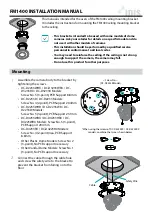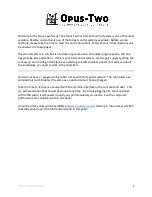
5
Mounting
5.1
Mounting instructions
•
Observe the technical data.
•
Protect the sensor from direct sunlight.
•
To prevent condensation, avoid exposing the device to rapid changes in tempera‐
ture.
•
The mounting site has to be designed for the weight of the device.
•
The device can be mounted in any position.
•
It should be mounted so that it is exposed to as little shock and vibration as possi‐
ble. Optional mounting accessories are available,
•
Regularly check the tightness of the fixing screws.
•
For indoor mounting, use a protection hood if necessary, for outdoor installation
use a weather protection hood if necessary (both optional accessories),
.
•
Do not mount the device on or directly in front of a bright metallic surface or other
reflective surface, since reflections can falsify the measurements.
•
Do not place magnetic objects on the optics cover, since they can disturb the
angular measurement.
•
Avoid having shiny or reflective surfaces in the scanning range, e.g., stainless
steel, aluminum, glass, reflectors, or surfaces with these types of coatings.
•
Protect the device from moisture, contamination, and damage.
•
Make sure that the status indicator is clearly visible.
•
Do not affix any labels or stickers to the optics cover.
•
Do not subject the device to excessive shock or vibrations. In systems subjected to
heavy vibrations, secure the fixing screws with screw-locking devices.
5.2
Mounting device
1.
Mount the device in a suitably prepared bracket using the fixing holes provided
(
see "Dimensional drawing", page 49
). Mounting brackets are available as acces‐
sories,
2.
Make the electrical connection. Attach and tighten a voltage-free cable,
necting the device electrically", page 38
3.
Align the vertical center line of the field of view of the device with the center of the
area to be monitored. The marking on the upper side of the optics hood serves as
a bearing alignment aid.
4.
Switch on the supply voltage.
✓
After successful initialization, the two status LEDs light up green. The device is
ready for use.
5.
Perform a fine adjustment using a test target and, if necessary, use the alignment
aid.
5.3
Mounting multiple devices
NOTICE RISK OF INTERFERENCE FROM OTHER DEVICES!
Radiation sources with a wavelength of 850 nm can cause interference if they affect
the device directly.
The device has been designed to minimize the probability of mutual interference,
including between different LiDAR sensors. To rule out even the slightest effects on the
measurement accuracy, the devices should be arranged such the laser beams are not
received by another device.
5
MOUNTING
30
O P E R A T I N G I N S T R U C T I O N S | LMS1104C-111031S01
8023051/1AZG/2021-05-10 | SICK
Subject to change without notice
















































